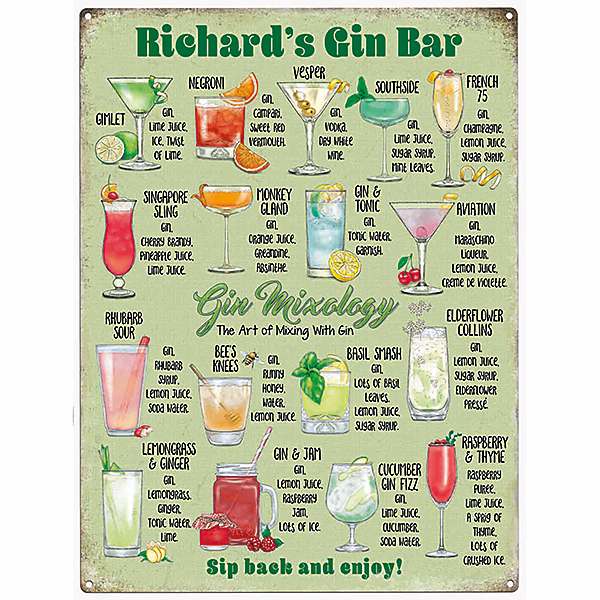The purposes of bar signposts can differ greatly. Bar signs are used for many different purposes. Branding
Purpose: To create and enhance the brand image of the bar.
Features: Include the bar's logo, name and colors. The idea behind this feature is to stand out and reflect the overall theme of the bar.
Examples: Neon signs with the logo of the bar, custom-made metal signs with the bar's name.
2. Information
The purpose of this guide is to provide essential information to clients.
Features: Simple-to-read, clear text that communicates important information such as working hours, Wi-Fi passwords or house rules.
For instance, a notice at the entrance that states operating hours, or points to the toilets.
3. Decorate your house with these Decorative Items
Purpose : To improve the appearance and atmosphere of the bar.
Bar decor is usually more artistic or themed. The bar may not have specific information or text.
Examples include: old advertisements for beer, humorous signs, or even quirky art.
4. Promo Codes
Purpose : To promote a specific product, event or a particular.
Features: Attractive designs that draw attention to special promotions, events that are coming up, or new items on the menu. Can include temporary elements or re-usable elements.
For example, chalkboards with daily offers, banners that advertise happy hour, and posters advertising events coming up.
5. Directional
The goal of this guide is to guide customers to the bar.
Highlights: Clear arrows or instructions for customers to navigate the bar, for example, finding the bathrooms, exits or different locations within the bar.
Examples: Signs that point to bathrooms, "Exit" signs, directions arrows to different seating areas.
6. Regulatory/Compliance
Obligation: Keeping in line with the legal requirements, and ensuring security.
Specifications: Signs essential to meet legal requirements such as smoking areas such as occupancy limits, smoking areas or emergency exits.
Signs that ban smoking, limit occupancy or indicate emergency exits are examples.
7. Interactive
The aim of this project is to involve customers through an engaging experience.
Specifications: Features that stimulate interaction among patrons, such as interactive surfaces or write-on surfaces.
For instance, chalkboards that can be used to write messages to customers or signs with QR code links to digital menus and social media.
8. Thematic
Set up a specific style or theme.
Themes: Signs that are in line with the bar's theme and contribute to the overall ambience.
Examples: Pirate themed signs in the nautical bar, rustic wood signs in an a country bar.
9. Menu
Use to display the menu of bars.
Features: Clear list of food and drinks and beverages, often with price. It is able to be changed or fixed.
Examples of wall-mounted menus for drinks or digital screens showing the menu items that rotate.
Each bar signage type is designed to serve a unique function and has been specifically designed for this reason. When they understand these distinctions, bar owners can select and position signs efficiently to enhance patrons' experiences and meet operational needs. Take a look at the top rated pub bar signs tips for blog advice including personalised cocktail bar sign, personalised outdoor pub signs, home garden bar signs, personalised metal pub signs, personalised pub, large pub sign, small pub signs, gin bar sign, personalised home pub sign, make a pub sign and more.

How Do Bar Signs Differ With Regards To Durability?
The durability of bar signs can vary depending on the material, construction and location and the purpose for which they are intended. Here's a look at how bar signs differ with respect to durability: 1. Material
Metal signs are impervious to rust and are durable They can also be used outdoors.
Wood: Solid wood signs are long-lasting, but they might require maintenance to avoid becoming rotten or warping.
Acrylic: Lightweight and durable, acrylic signs are not susceptible to shattering and can stand up to outdoor exposure.
Neon/LED Neon signs tend to be fragile and easily damaged. LED signs are on the other hand robust and durable. They are also more energy-efficient.
2. Weather Resistance
Outdoor Signs. The materials and the coatings used should be resistant to corrosion, fading and water damage.
Indoor Signs for indoor use. While indoor signs may not be exposed to extreme conditions, they should resist humidity, temperature changes, and wear.
3. Construction
Solid Construction: Signs that have robust frames, reinforced corners, and sturdy mounting hardware are more resilient to damage.
Sealed Components Signs with sealed electronic components (for illuminated signs) are less prone to water-related damage.
4. Maintenance Requirements
Low Maintenance: Bars with busy owners could benefit from signs that are low maintenance.
High Maintenance Signs that have intricate designs, delicate materials, or have special requirements for maintenance can be expensive and time-consuming.
5. Location
Indoor signs are generally less prone to environmental hazards. They may also have less durability requirements than outdoor signs.
Outdoor Signs: Outdoor signs require greater strength to withstand the effects of the elements of wind, sunlight, rain, and temperature fluctuations.
6. Impact Resistance
Signs that are heavy duty Signs that are intended for areas with high traffic or places where they might be damaged (e.g. bars) should be constructed of sturdy materials that are resistant to scratching or dents.
Signs with laminated or protective surfaces are less likely to be damaged by scratches, spills or vandalism.
7. Longevity
Longevity. Signs that are durable will last for several years, with minimal or no degradation. They're an excellent investment for bar owners.
Use for short-term purposes: Signs that are designed for events and promotions that are temporary may not be as durable or long-lasting as permanent signage.
8. Lighting
Lighting Components: Signs that are illuminated using neon or LED lighting should be made of high-quality, long-lasting components to ensure longevity and durability.
9. Environmental Impact
Signs that are made from recycled and sustainable materials may lessen the impact on the environment. They still provide durability and functionality.
10. Customization
Custom Options: Signs that offer customization options may have varying degrees of durability based on the materials used and the production methods employed.
Durability is an asset.
Durability: A durable sign requires less frequent replacement and maintenance and maintenance, which can reduce costs over the long run.
Brand Image - High-quality signs that are durable and long-lasting reflect the professionalism of bars.
Customer Satisfaction - Signs in good condition can enhance the general atmosphere of the bar, and help create the satisfaction of customers.
When considering elements such as the material, construction and site requirements, bar owners are able to select signage solutions which will provide the durability needed to withstand their environment. They also can add value in the long run. View the recommended man cave signs for blog recommendations including hanging bar sign, personalised pub signs for garden, make a bar sign, pub signs made, personalised cocktail sign, bar signs for home, large personalised bar signs, bar signs, outdoor personalised bar sign, large pub sign and more.

What Is The Difference Between The Bar Signs In Regulations And Other Bar Signs?
Bar signs are subject to a variety of regulations by local, state and federal authorities in order to ensure public security and aesthetic standards, as well as compliance with zoning law. There are a few differences between bar signs and their regulations. There are rules regarding the size and location of signs.
Zoning laws: These rules determine the size, height and distance of signs from properties or adjacent buildings.
Historic Districts: Signs could be restricted in order to preserve the historical nature of certain districts. This may include restrictions regarding size, design, and the material.
2. Illumination Restrictions
Light Pollution: Regulations may limit the brightness, colors and time of illuminated signs to minimize light pollution and protect the nighttime ambience.
Safety Concerns Signs are not able to cause glare or hinder drivers or pedestrians, especially when placed near the road.
3. Signage Content
Alcohol Advertising - Some jurisdictions have limitations on alcohol-related advertising. They include a ban on certain imagery or content that attracts minors or encourages excessive drinking.
Health Warnings: Laws could require health warnings on the dangers of drinking alcohol or smoking.
4. Historic Preservation Regulations
Signs that are located in historic districts have to be in line with the architectural style or character of the area. This requires the approval of preservation boards.
Design and Materials - Limitations could be placed on design, designs, materials or color schemes in order to ensure historical integrity.
5. Sign Permitting Process
Permit Requirements Bar owners need to obtain permits before they can install or modify signs. This may involve paying fees, submitting designs, and getting local authority approval.
Code Compliance: Signs must to conform with building codes and fire safety regulations, as and accessibility standards in order to maintain public safety and to ensure accessibility for those who are disabled.
6. Maintenance and removal of Signs
Maintenance Requirements Owners of bars must keep their signs in good condition make sure they are safe and structurally sound, and free of dangers. Additionally, they must be compliant with the regulations.
Abandoned Signs - Regulations can be enacted to remove old and deteriorated signs to stop blight and keeping the appearance of the area around it.
7. Digital Signage Regulations
Content Restrictions. There are laws that restrict the types of content that is displayed on digital signs. They could also ban flashing lights or images that offend.
Limitations to Operation: Regulations could restrict the intensity, brightness or frequency of changes in digital signs to limit visual clutter and distracting.
8. Enforcement and Penalties
Inspections Local authorities conduct routine inspections to ensure the compliance of signage regulations, issuing citations for violations.
Penalties - Penalties could include fines or court orders, requests for signs to be taken down or modified, and legal actions.
9. Sign Variance Process
Variance applications bar owners who wish to alter their signage in accordance with the rules can do it by submitting a request for an exemption. Justification should be provided as well as any negative effects on public security or appearance should be considered.
Public input: Changes could require public meetings, or input from local community, owners of property living in close proximity, or from business groups.
10. Community Input and Engagement
Public Consultation: Certain areas involve residents in the creation of signage regulations through public forums, surveys or stakeholder meetings.
Community Benefits: Sign regulations could include provisions to improve the quality of signage or advertise local businesses. It could aid in revitalizing neighborhoods.
Bar owners who know and adhere to signage regulations can ensure that their signage are appealing to patrons, thereby benefitting their community, while also meeting the legal regulations. This reduces the risk of legal issues as well as penalties or fines. Take a look at the top rated bar runners examples for website examples including hanging home bar signs, to the bar sign, personalised hanging pub signs, pub wall sign, personalised pub signs, hanging home bar signs, signs for the bar, novelty bar signs, personalised signs for bar, pub bar signs and more.
